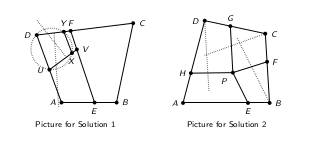Difference between revisions of "1972 IMO Problems/Problem 2"
| Line 54: | Line 54: | ||
[[File:prob_1972_2.png|600px]] | [[File:prob_1972_2.png|600px]] | ||
| + | Before giving the missing details, let us remember that a quadrilateral | ||
| + | <math>ABCD</math> is inscribable if and only if a pair of opposing angles andds | ||
| + | up to <math>\pi</math>, in other words <math>\angle A + \angle C = \pi</math>, or equivalently, | ||
| + | <math>\angle B + \angle D = \pi</math>. In particular, any isosceles trapezoid is | ||
| + | inscribable. | ||
Revision as of 16:43, 26 March 2025
Contents
Problem
Prove that if ![]() , every quadrilateral that can be inscribed in a circle can be dissected into
, every quadrilateral that can be inscribed in a circle can be dissected into ![]() quadrilaterals each of which is inscribable in a circle.
quadrilaterals each of which is inscribable in a circle.
Solution
Our initial quadrilateral will be ![]() .
.
For ![]() , we do this:
, we do this:
Take ![]() with
with ![]() sufficiently close to
sufficiently close to ![]() respectively. Take
respectively. Take ![]() such that
such that ![]() is an isosceles trapezoid, with
is an isosceles trapezoid, with ![]() close enough to
close enough to ![]() (or
(or ![]() close enough to
close enough to ![]() ) that we can find a circle passing through
) that we can find a circle passing through ![]() (or
(or ![]() ) which cuts the segments
) which cuts the segments ![]() in
in ![]() . Our four cyclic quadrilaterals are
. Our four cyclic quadrilaterals are ![]() .
.
For ![]() we do the exact same thing as above, but now, since we have an isosceles trapezoid, we can add as many trapezoids as we want by dissecting the one trapezoid with lines parallel to its bases.
we do the exact same thing as above, but now, since we have an isosceles trapezoid, we can add as many trapezoids as we want by dissecting the one trapezoid with lines parallel to its bases.
The above solution was posted and copyrighted by grobber. The original thread for this problem can be found here: [1]
Remarks (added by pf02, March 2025)
The construction described in the solution above is correct (in the sense that it describes a legitimate way of dissecting an inscribable quadrilateral into four inscribable quadrilaterals). However, the solution is incomplete and sloppily written.
Below I will discuss and complete the solution given above.
Then, I will give a second solution. And finally, I will
discuss the cases when ![]() .
.
Discussion and completion of the above solution
The first issue is the fact that a construction is described, but there is no proof, not even a hint, why the the quadrilaterals are inscribable.
The second issue is the vagueness of "close enough" used twice
in the proof. The first time it is used, "![]() sufficiently
close to
sufficiently
close to ![]() respectively" is not needed (indeed, and segment
respectively" is not needed (indeed, and segment
![]() parallel to
parallel to ![]() would do), so there is no need to make
this more precise. The second time it is used, namely "
would do), so there is no need to make
this more precise. The second time it is used, namely "![]() close enough to
close enough to ![]() (or
(or ![]() close enough to
close enough to ![]() ) that we can
find a circle passing through
) that we can
find a circle passing through ![]() (or
(or ![]() )" is indeed
needed, and it is not at all clear what "close enough" should
be, or that this is at all possible. I will come back to this
shortly.
)" is indeed
needed, and it is not at all clear what "close enough" should
be, or that this is at all possible. I will come back to this
shortly.
The third (and maybe most serious) issue is that it is not shown, and not clear at all, that the four quadrilaterals obtained are inscribable. I will give the proof shortly.
The fourth issue is poor wording. We don't need to "add as many trapezoids as we want". We want to dissect the one isosceles trapezoid into as many isosceles trapezoids as we want by lines parallel to its bases.
Before giving the missing details, let us remember that a quadrilateral
![]() is inscribable if and only if a pair of opposing angles andds
up to
is inscribable if and only if a pair of opposing angles andds
up to ![]() , in other words
, in other words ![]() , or equivalently,
, or equivalently,
![]() . In particular, any isosceles trapezoid is
inscribable.
. In particular, any isosceles trapezoid is
inscribable.
TO BE CONTINUED. SAVING MID WAY, SO I DON'T LOOSE WORK DONE SO FAR.
See Also
| 1972 IMO (Problems) • Resources | ||
| Preceded by Problem 1 |
1 • 2 • 3 • 4 • 5 • 6 | Followed by Problem 3 |
| All IMO Problems and Solutions | ||










